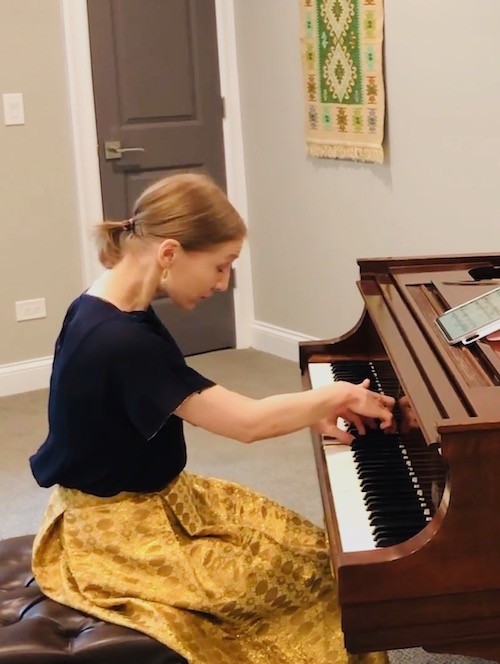Kaleidoscope MusArt finds art in small things with bagatelle program

The Covid 19 pandemic has forced musical organizations around the globe to find new ways to present and transmit concert performances. Miami’s innovative Kaleidoscope MusArt has specialized in programming contemporary and rarely played piano repertoire.
On Saturday evening the organization opened a free virtual season online with “Peek into the Infinite I,” an enticing program of bagatelles celebrating the 250th anniversary of the birth of Ludwig van Beethoven. Each of the three pianists who took part recorded their performances in their homes in Albany, Chicago and Miami and each introduced each work live via the internet. The entire program was produced in a highly professional manner with clear and present sound quality and fine graphics. (The concert will be accessible online through October 17 at the Kaleidoscope website.)
Bagatelle is the French word for trifle but Beethoven turned these miniatures into superbly crafted vignettes. The master from Bonn wrote no less than three sets of these brief works.
Pianist Akina Yura opened the concert with his Seven Bagatelles, Op. 33. Written in 1801-1802 and contemporaneous with the Second Symphony and monumental Eroica Variations, these short pieces vividly display Beethoven’s ability to charm as well as storm the heavens.
Yura (who teaches at the College of Saint Rose in Albany and Rensselaer Polytechnic Institute in Troy, NY) brought impressive technical command melded with artful phrasing and dynamic control to each movement. She captured the Viennese dance rhythms and verve with idiomatic flair. Her fleet fingering and sense of playfulness were a particular delight in the Allegretto of the fifth bagatelle and she brought out the impish humor of the final Presto.

Many composers have contributed bagatelles to the keyboard literature, bringing their own style and heritage to the form. Kaleidescope MusArt director Inesa Gegprifti, who hosted the program, played Four Bagatelles (1987-88) by Michael Coleman, a faculty member at the University of North Florida in Pensacola. The work was a winner of the series’ 2020 Call for Scores program.
While basically atonal, Coleman manages to span a wide range of colors and instrumental effects in his variants, the pulse ranging from quietly poetic to jazzy. Gegprifti (an adjunct faculty member at the University of Miami’s Frost School of Music and a critic for South Florida Classical Review) played these lovely compositions with pinpoint agility and incisiveness.

Béla Bartók conceived his Fourteen Bagatelles, Op. 6, around 1908 during his unrequited love affair with the violinist Stefi Geyer. In addition to folk influences, his rollercoaster of romantic emotions inspired by Geyer hold sway over these alternately austere, enigmatic and propulsive essays. Maria Sumareva (who teaches at Loyola University in Chicago) was fully equal to Bartók’s pyrotechnical challenges, commanding and accenting the shifting moods of these remarkable cameos. She conveyed the majestic nostalgia of the Hungarian folk song in the fourth section and infused dance-like spirit into the Slovakian Vivo of the fifth. Sumareva displayed speed and power to spare as well as a sensitive and delicate touch. There was an aura of tragic darkness in “Elle est morte” (She is dead – no XIII), suggesting the end of the composer’s affection for Geyer. The final Valse (later orchestrated as the second of Bartók’s Two Portraits for Orchestra) abounded in quirky lightness.
Yura concluded the program with Five Bagatelles, Op. 9 by British composer and musicologist Howard Ferguson (1908-1999). Ferguson, a pupil of Vaughan Williams and Malcolm Sargent wrote these works during World War II and they reflect the dark time when London was being bombed and the future looked bleak. At times solemn but lyrical, Ferguson’s expressive pieces also suggest a more witty, optimistic side. Yura injected the Shostakovich-like irony of the final Allegretto non troppo with high style and her subtle tone fully encompassed the softer, more pastoral segments.
The performance was accompanied by an animated video created by artist Shima Iuchi. While this may have proved a distraction in a live concert performance, it worked wonderfully online. Iuchi’s images of war planes across the sky, London and Big Ben, the palm trees of Miami and imprints of the piano’s strings and hammers on carbon paper matched the varied palette of Ferguson’s mood painting. The entire program demonstrated the diversity and variety of creative approaches to the bagatelle.
Kaleidoscope MusArt presents Peeks into the Infinite II featuring pianists Andrew Rosenblum, Redi Llupa, Maria Sumareva and Lindsay Garritson playing bagatelles by Beethoven, Elizabeth Lutyens, Carl Vine and Jane O’Leary 5 p.m. October 24. The web stream is free but registration is required. kaleidoscopemusart.com.
Posted in Performances
Leave a Comment
Sun Oct 11, 2020
at 12:40 pm
No Comments




